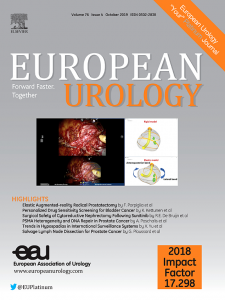A Comprehensive Systematic Review and Meta-analysis of the Role of Prostate-specific Membrane Antigen Positron Emission Tomography for Prostate Cancer Diagnosis and Primary Staging before Definitive Treatment
IF 25.3
1区 医学
Q1 UROLOGY & NEPHROLOGY
引用次数: 0
Abstract
Background and objective
Positron emission tomography (PET) with prostate-specific membrane antigen (PSMA) in the diagnosis and primary staging of patients with prostate cancer (PCa) has an established role, but recent summative evidence on its actual diagnostic and staging value is still missing. We aimed to collect and analyze published studies reporting the accuracy of PSMA PET for the diagnosis of clinically significant prostate cancer (csPCa) and detection of distant metastases at primary staging before definitive treatment.
Methods
We performed a systematic review of the literature, by searching the PubMed/MEDLINE, Cochrane library’s CENTRAL, EMBASE, and Scopus databases, from inception to April 2024. Two coprimary outcomes were assessed: first, to evaluate the sensitivity, specificity, positive (PPV) and negative (NPV) predictive values of PSMA PET in detecting intraprostatic csPCa on a per-patient level, and second, to assess the positivity rates of metastatic disease in the primary staging, prior to definitive therapy. As a secondary outcome, the diagnostic accuracy of PET PSMA for the detection of lymph nodal invasion (LNI) was tested in a per-patient–level analysis of studies where pelvic lymph node dissection (PLND) was available as the reference standard. Positivity and detection rates were pooled using random-effect models. Preplanned subgroup analyses tested the diagnostic accuracy of PET PSMA across different study cohorts. Variation in PPV and NPV over csPCa and LNI prevalence was evaluated.
Key findings and limitations
In total, 12 and 99 studies, with a total of 1533 and 18 649 participants, respectively, were included in the quantitative synthesis for intraprostatic diagnosis and staging. For intraprostatic disease, the sensitivity, specificity, PPV, and NPV of PSMA PET for csPCa were 82% (95% confidence interval [CI] 73–90%), 67% (95% CI 46–85%), 77% (95% CI 63–88%), and 73% (95% CI 56–87%), respectively. At a bivariate analysis, the diagnostic accuracy of PSMA PET estimated through a summary receiver operating characteristic curve–derived area under the curve was 84%, increasing up to 88% when combined with magnetic resonance imaging (MRI). On staging level, PSMA PET results were positive outside the prostate in 23% of the patients, with substantial variation in positivity rates between high-risk (31%) and intermediate-risk (12%) subcohorts. When using PLND as the reference standard (51 studies, 7713 patients), the sensitivity, specificity, PPV, and NPV of PSMA PET were, respectively, 54%, 94%, 77%, and 86%. With higher csPCa and LNI prevalence, a similar increase in PPV and a decrease in NPV were observed.
Conclusions and clinical implications
The current updated systematic review and meta-analysis provides updated evidence on the diagnostic and staging accuracy of PSMA PET in PCa. We reported good accuracy of PSMA PET to discriminate csPCa, particularly when added to MRI, but NPV alone is insufficient to omit a biopsy. Regarding staging, PSMA PET cannot be used alone to determine the need for lymph node dissection (LND) and should be combined with additional clinical information within predictive tools. As such, further research should develop and validate models that incorporate PSMA PET to reliably inform biopsy or LND.
前列腺特异性膜抗原正电子发射断层扫描在前列腺癌诊断和最终治疗前的初级分期中的作用的综合系统综述和meta分析
背景与目的正电子发射断层扫描(PET)与前列腺特异性膜抗原(PSMA)在前列腺癌(PCa)患者的诊断和初步分期中的作用已经确立,但其实际诊断和分期价值目前尚缺乏近期的结论性证据。我们的目的是收集和分析已发表的研究报告,这些研究报告了PSMA PET在诊断临床显著性前列腺癌(csPCa)和在最终治疗前的初级阶段检测远处转移的准确性。方法通过检索PubMed/MEDLINE、Cochrane图书馆的CENTRAL、EMBASE和Scopus数据库,对从成立到2024年4月的文献进行系统综述。评估了两个主要结果:第一,评估PSMA PET在每个患者水平上检测前列腺内csPCa的敏感性、特异性、阳性(PPV)和阴性(NPV)预测值;第二,评估原发性转移性疾病的阳性率,在最终治疗之前。作为次要结果,PET PSMA检测淋巴结浸润(LNI)的诊断准确性在每个患者水平的研究分析中进行了测试,其中盆腔淋巴结清扫(PLND)可作为参考标准。采用随机效应模型合并阳性率和检出率。预先计划的亚组分析测试了PET PSMA在不同研究队列中的诊断准确性。评估PPV和NPV随csPCa和LNI患病率的变化。总共有12项和99项研究,分别有1533名和18649名参与者被纳入前列腺内诊断和分期的定量综合。对于前列腺内疾病,PSMA PET对csPCa的敏感性、特异性、PPV和NPV分别为82%(95%可信区间[CI] 73-90%)、67% (95% CI 46-85%)、77% (95% CI 63-88%)和73% (95% CI 56-87%)。在双变量分析中,通过汇总接收者工作特征曲线下衍生面积估计的PSMA PET诊断准确率为84%,与磁共振成像(MRI)结合时增加到88%。在分期水平上,23%的患者PSMA PET结果在前列腺外呈阳性,在高风险(31%)和中危(12%)亚队列之间的阳性率有很大差异。以PLND为参比标准(51项研究,7713例患者),PSMA PET的敏感性、特异性、PPV和NPV分别为54%、94%、77%和86%。随着csPCa和LNI患病率的升高,观察到PPV的升高和NPV的降低。结论和临床意义当前更新的系统综述和荟萃分析为PSMA PET在PCa中的诊断和分期准确性提供了最新证据。我们报道了PSMA PET鉴别csPCa的良好准确性,特别是当与MRI结合使用时,但单纯的NPV不足以忽略活检。关于分期,PSMA PET不能单独用于确定是否需要淋巴结清扫(LND),而应与预测工具中的其他临床信息相结合。因此,进一步的研究应该开发和验证包含PSMA PET的模型,以可靠地为活检或LND提供信息。
本文章由计算机程序翻译,如有差异,请以英文原文为准。
求助全文
约1分钟内获得全文
求助全文
来源期刊

European urology
医学-泌尿学与肾脏学
CiteScore
43.00
自引率
2.60%
发文量
1753
审稿时长
23 days
期刊介绍:
European Urology is a peer-reviewed journal that publishes original articles and reviews on a broad spectrum of urological issues. Covering topics such as oncology, impotence, infertility, pediatrics, lithiasis and endourology, the journal also highlights recent advances in techniques, instrumentation, surgery, and pediatric urology. This comprehensive approach provides readers with an in-depth guide to international developments in urology.
 求助内容:
求助内容: 应助结果提醒方式:
应助结果提醒方式:


